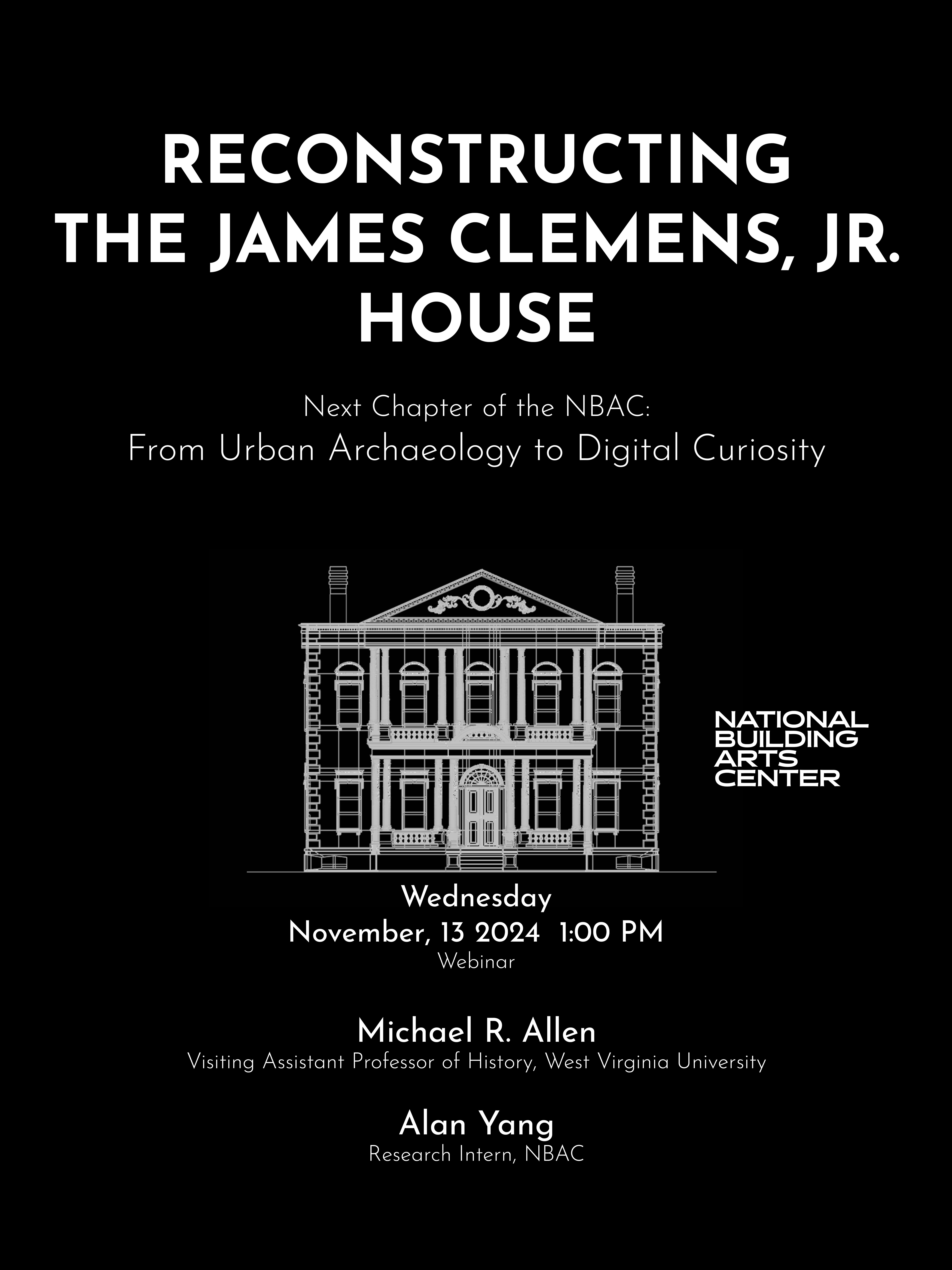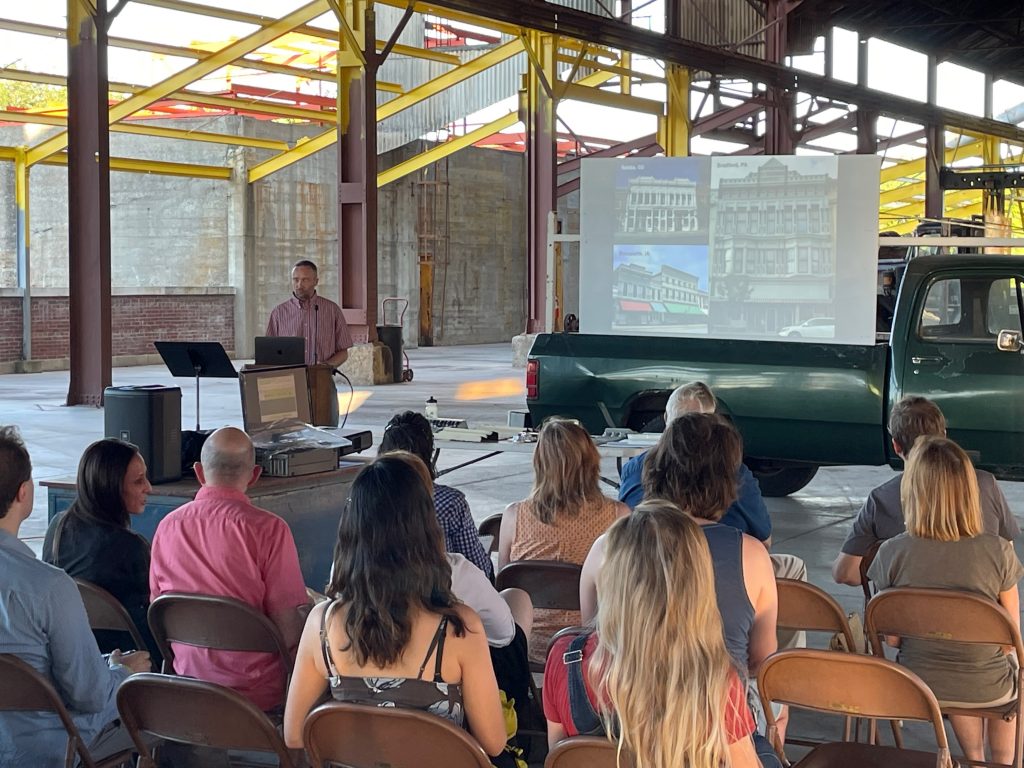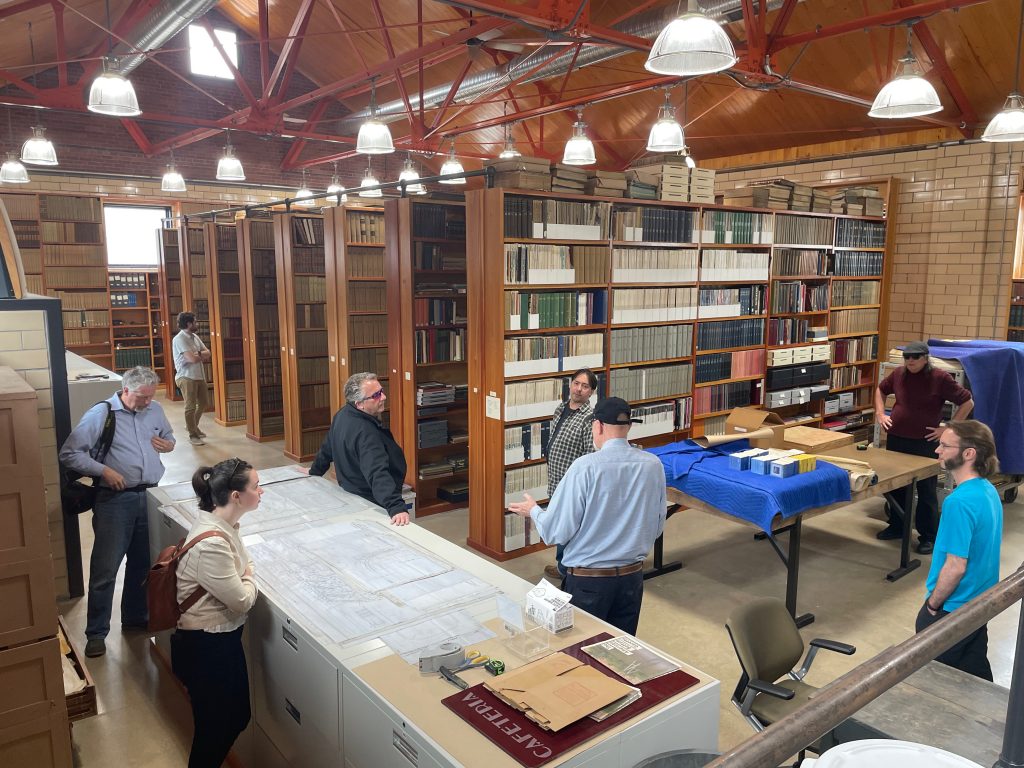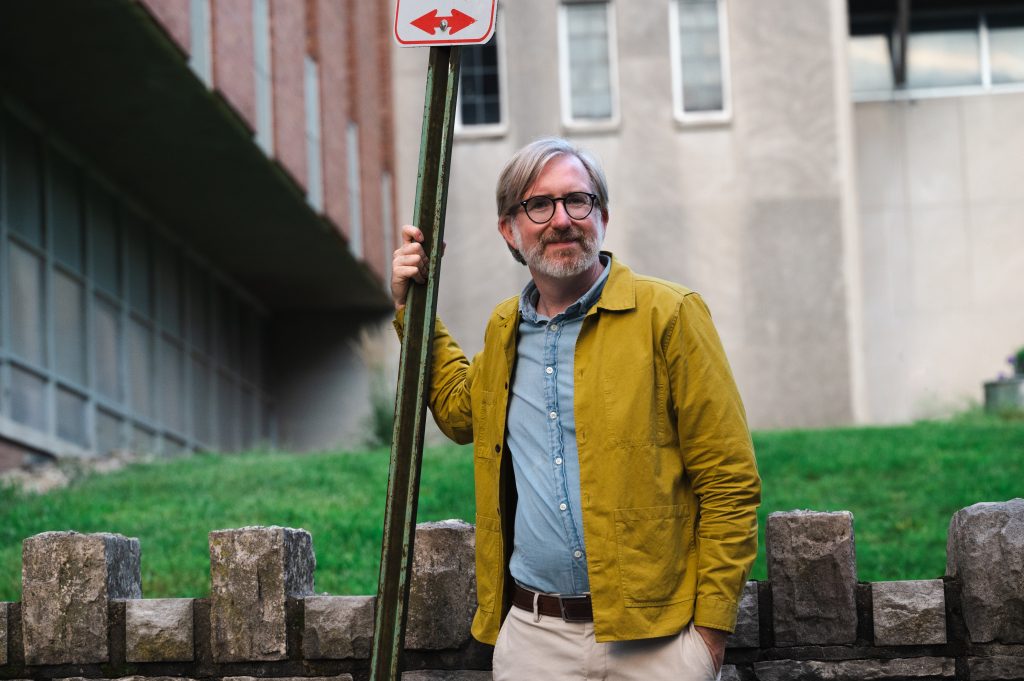Our webinar, “Reconstructing the James Clemens, Jr. House”, was held on November 13, 2024. The recording is now available on YouTube.

Our webinar, “Reconstructing the James Clemens, Jr. House”, was held on November 13, 2024. The recording is now available on YouTube.

From President Mike Jackson, FAIA, and Executive Director Michael R. Allen
The National Building Arts Center (NBAC) is an unparalleled endeavor, joining the nation’s largest collection of architectural artifacts with a vast, comprehensive library and archive on the built environment. Located in a historic steel casting foundry near St. Louis, NBAC is a museum in the making – a truly epic project started by the late salvage expert and preservationist Larry Giles.
For some of you reading, NBAC may be the coolest preservation organization that you have never heard of. For others, NBAC may be a project that you have visited once before or just read about somewhere. You may wonder when this museum will finally open its doors and get up and running.
We’re here to tell all of you that the day has arrived. The NBAC is up and running – in many ways that we are thrilled to share:
Staffing: In September, Michael Allen moved from President of the Board of Directors to Executive Director. Michael already has plotted a draft strategic vision for the next five years of NBAC, identified new programs and sources of funding, and has been an ambassador literally across the globe. Emery Cox, Archives and Collections Manager, has celebrated his one-year anniversary as our first full-time employee. We remain amplified by a platoon of volunteers who work on facilities, events, graphic design and research. Of course, we want to grow our ranks even further.
Collaboration: We are pleased to announce that we are collaborating with the Pulitzer Arts Foundation on a major exhibition of artifacts from our collections set to open at the Pulitzer in September 2023. The exhibit will allow us to demonstrate the power of our collections to tell captivating, challenging stories around the built environment. A course at Washington University in St. Louis’ Sam Fox school of Design and Visual Arts also will support the exhibition. In August, the Missouri History Museum included NBAC in the opening of its Coloring St. Louis exhibition.
APT Collaboration: We have continued our contributions to the Association for Preservation Technology (APT) Building Technology Heritage Library, a free, public online repository. This summer, our intern Paul Davey scanned 202 documents (spanning 7,218 pages) and added them to the Library. With help from Paul and volunteer, NBAC has posted almost 700 documents relating to terra cotta, cast iron and brick to the Building Technology Heritage Library.

Tours and Programs: We have now completed over one year of regular docent-led tours of our collections (have you been?), and we plan to continue. Our first summer lecture series – including talks on cast iron storefronts, terra cotta in St. Louis, problems in building rehabilitation and the Mesker Brothers sheet metal fronts – drew steady attendance. We are planning additional programs, including special tours of the library and archives offering a deep dive into our holdings. We also will be branching out to other cities, with plans for events in New York City already underway.
Appearances: Our staff and board members served on panels or gave lectures throughout the year, including at the annual gathering of the Walter Burley Griffin Society in Chicago, The Cultural Landscape Foundation’s What’s Out There Weekend, the Indiana Statewide Historic Preservation Conference and the Ironbridge Centre for Heritage at the University of Birmingham, UK. Additionally, we answered scores of email and phone inquiries, participated in media interviews and otherwise made our people available to share knowledge.
Collections: Directed by Emery Cox, we finally have begun the herculean task of cataloging our library volumes, archival materials and built environment artifacts. This work has shown us that we have probably underestimated the scope of our holdings! Very soon we will open the database to the public, 24/7 and free of charge. We recently have partnered with Landmarks Association of St. Louis and the Southern Illinois University-Edwardsville Museum to offer solutions for artifact storage.

Accessions: Although we are not actively working on large-scale recovery projects these days, we have accessioned nearly 1,000 items in the last year (books, archival materials and artifacts). Gifts have ranged from the White Pine Monographs to mid-century modern glass block. Staff have ensured that each item comes with a contract of gift and is entered into our catalog. We also are pleased to announce that – after years of planning and pandemic supply chain disruptions – “Little Liberty,” the Statue of Liberty replica gifted to us by the Brooklyn Museum will arrive in 2023. We plan events both in New York City and at NBAC to commemorate this American odyssey.
Facilities: Last, but never least, is the historic Sterling Steel Casting foundry that we call home. This year we added new signage – with more being added soon – to make NBAC more visible to visitors. We now have an NBAC campus guide with map of our collections for visitors to use. We finished a perimeter fence so that the collections are now 100% secure. We have made safety and accessibility modifications. The Illinois Painters District Council Local 58 sent apprentices to help us continue restoring the safety yellow in our main foundry building. The facility needs are vast, but we have made progress in making the facility more user-friendly.
While our founder set us on a path toward success, we have accelerated progress. To keep up this pace, your support is invaluable. We wish you a wonderful end of the year, and look forward to the work we can do together next year!
Please join us in building on this momentum by making a tax-deductible contribution. Donate here.

The National Building Arts Center is excited to announce that its Board has appointed Michael Allen as Executive Director, starting September 1. Michael has been serving as President of the Board since June 2021, but he actually has been involved since before the project was called NBAC. Starting out ironing drawings from the Guth Lighting Company as an intern in 2004, Michael worked as a part-time assistant when the St. Louis Building Arts Foundation (precursor to NBAC) purchased the Sterling Steel Casting plant. He joined the Board of Directors in 2009.
For the last 13 years, Michael has been director of the Preservation Research Office, a consultancy that has worked on historic preservation projects in 11 US states. In 2018, the National Trust for Historic Preservation named Michael to its “40 Under 40” list of young preservation leaders. Michael will take on the role at NBAC half-time while maintaining his academic position at Senior Lecturer in Architecture, Landscape Architecture and Urban Design at Washington University in St. Louis. Michael continues to work on Housing Blocs, an international collaborative research project on public housing in the US and post-socialist Europe as well as his doctoral dissertation and (hopefully) finishing restoring the wooden windows on his 1910 house in St. Louis’ Dutchtown neighborhood.
Sauget, Illinois
June 12th, 2021
Larry Giles, nationally renowned preservationist and President of the National Building Arts Center, died today of complications from cancer treatment. Larry started work on the Center in 1982 in response to Eero Saarinen’s proposal for a museum of American architecture on the Saint Louis riverfront. In 2002, Larry donated the inventory from his architectural salvage business to the newly incorporated organization and later oversaw the move to its current location in Sauget, Illinois. Under Larry’s leadership, the Center has become the world’s largest repository of several categories of building-related materials, from architectural terra cotta to cast iron storefronts, and a destination for researchers worldwide. The organization remains committed to Larry’s vision, and its staff and volunteers are already working to realize the next phase of the plans that Larry’s tireless work put in motion. The Center is planning a memorial for Larry and will announce plans shortly.
July 7th, 2021
Larry Giles leaves behind a rich legacy of preserved artifacts, enriched lives, and an organization dedicated to continuing his mission. On August 7th, 2021, join his family and friends at the museum he built to celebrate that legacy and that mission.
Site tours and a reception begin at 4:00 PM, with the main program starting at 5:00 PM.
Reservations are required; please see the Eventbrite page.
Intern Positions Available at the National Building Arts Center
The St. Louis-based National Building Arts Center (NBAC; nationalbuildingarts.org) seeks applications for internships in cataloging, conserving and sorting its material and library collections. The internship can begin any time.
The NBAC promotes public awareness of the crucial roles of architecture, manufacturing, construction, and urban design in our built environment.
Located in Sauget, Illinois, the NBAC is a unique, emergent study center housing the nation’s largest and most diversified collection of building artifacts, supported with a research library offering broad holdings in architecture and allied arts. Our collection represents the single largest effort toward understanding the American built environment and the historical process of its creation.

Description of Internship
Projects
Interns may perform needed tasks on the following projects:
Contact
Emery Cox
emery@nationalbuildingarts.org
314-922-5500
National Building Arts Center
2300 Falling Springs Road
Sauget, IL 62206
When the Missouri History Museum was creating its new exhibit A Walk in 1875 St. Louis, not surprisingly it turned to the National Building Arts Center to enhance the display with building artifacts. The exhibit presents a look at St. Louis in the year that Compton & Dry published their famous bird’s-eye perspective, Pictorial St. Louis. Curator Andrew Wanko worked with the Center to include remnants of a flounder-style house once located in LaSalle Park known as “Hlas House.” The house likely dated to the 1850s.
[wpvideo z1OOv7ds]
The flounder-style house once standing at 1611 South 11th Street became the home of the Bohemian Publishing Society — the first Czech Catholic national publishing house in America — from 1908-1954. At this address, the Society published Hlas (“Voice”), an influential Czech-language newspaper. When the house was wrecked, Center founder Larry Giles recovered the entrance and a window complete with enframement, sash and shutters. These fully-restored items greet visitors to A Walk in 1875 St. Louis, setting the historic scene.
The installation can be seen as part of the exhibit through February 16, 2016.
He’s a former infantry squad leader in the Marine Corps whose company was the inspiration for the film “Full Metal Jacket.”
After seeing combat in Vietnam and leaving the military, Larry Giles went on to develop a passion for preservation, amassing the largest collection of building artifacts in the country over the past 40 years.
Having been a Marine “really helps with organizational skills and the ability to tackle large projects and stay with them,” said Giles, 66, who in 2007 created the National Building Arts Center, located on a 15-acre site in Sauget, Illinois.There, 13 buildings of the former Sterling Steel Casting Co. foundry house crate after crate of history in the form of sculptures, columns, friezes, ornamental brick, ironwork and terra cotta.
Giles has long hoped to display the collection, establish a research library and have a degree program in conservation through a local university, but funding has been an obstacle. Items range from an assortment of more than 2,000 door knobs representing various architectural periods to a complete facade from St. Louis’ Gaslight Square. There’s also a collection of more than 100 complete cast iron storefronts, an ecclesiastical collection with artifacts from local Catholic churches and a glass collection featuring the vaulted glass atrium dome from the 1902 National Bank of Commerce in St. Louis.
Giles estimates he has approximately 300,000 items on the site, which at first glance looks like a ghost town after having been the workplace of almost 300 foundry workers. While most of the collection is from St. Louis buildings, other cities represented include Chicago, Philadelphia, Los Angeles and New York.
There are also thousands of items intended for the research library, such as books, photographs, drawings, prints and other materials, including the world’s largest collection of architectural postcards, which date mostly to the late 1800s.
A longtime history lover, Giles owned St. Louis Architectural Art Co., an architectural recovery, materials conservation and building restoration firm, for nearly 30 years before establishing in 2002 the St. Louis Building Arts Foundation, which controls the center.
“Larry has this encyclopedic knowledge,” said Steve Trampe, founder of real estate firm Owen Development and chairman of the foundation. “He’s not trained and he doesn’t have a doctorate but he’s got it all in his head. You can talk about the history of structural steel or the history of French architecture in St. Louis. He lives and breathes this and knows it like no one else.”
The center’s holdings are so comprehensive that the Brooklyn Museum in New York chose to transfer most of its collection of architectural artifacts there over the past several years. It features several thousand pieces, including terra cotta, carved stone, cast iron, cast cement, woodwork and signage, Giles said.
What attracted you to architectural history and conservation? I’ve been fascinated by the city’s history and architecture since childhood. My grandmother’s boyfriend, whom I referred to as grandpa as a kid, was a real St. Louis history buff. There were very few details about the city that he wasn’t privy to. He got me interested in history and the history of St. Louis. We used to ride around the city and he’d tell stories and point out places and buildings.
Why did you start the St. Louis Architectural Art Co.? It evolved out of a rehab company I started in 1972 called Soulard Resources. I started it with a couple of architecture students from Wash U. At that time there were close to 300 empty buildings in Soulard, and we wanted to stabilize the buildings that were vacant and vandalized, find people to take them over and build a community again. Soulard at that time looked like Dresden after the bombing. We had a romantic vision about what the neighborhood could be. We even went on radio trying to promote the area. After a year or two we realized we didn’t have the financial horsepower to get the company off the ground. When we closed Soulard Resources I continued the salvaging of historic materials and started the St. Louis Architectural Art Co.
Where did you get the idea for a museum for building artifacts? The idea for an architectural study collection goes back to the late 1930s. It was first proposed for the Jefferson National Expansion Memorial by Charles Peterson of the National Park Service, who is largely considered the father of preservation in the United States. He had support from the St. Louis preservation community at the time to salvage significant parts of the buildings that were being demolished for the arch grounds. They saved and put in warehouses artifacts similar to what we’ve got here to become part of the Museum of American Architecture. That project was abandoned in the early 1950s by the Park Service and the collections were disbursed.
What are the most significant pieces in your collection? Probably the cornice from the Title Guaranty building, originally the Lincoln Trust building, on the southwest corner of Seventh and Chestnut. It’s one of the finest terra cotta cornices anywhere in the world. It’s a series of sculptured winged victory figures that surrounded the building at the top. It was designed by St. Louis’ most prestigious architectural firm, Eames and Young. It was built right across the street from the Wainwright Building.
What’s in your ecclesiastical collection? Altars, baptismal fonts, communion railings and statues. Most of the items are from former Catholic churches that were sold off by the Archdiocese when parishes were consolidated on the north side of St. Louis. We worked with the Archdiocese and agreed to dismantle and preserve a lot of the marble work from a half dozen really significant churches that were going to be sold off. There are probably about 100 crates of materials, and the crates are about 30 cubic feet each.
Where can people view some of the artifacts? At the Missouri Botanical Garden’s Temperate House behind the Climatron there’s a carved stone entrance from a former Catholic school. It’s permanently installed. The Sheldon Art Galleries have an installation. The Missouri History Museum has an exhibit called “Seeking St. Louis” with some artifacts from St. Louis buildings. There’s a cast iron storefront and examples of roofing tiles. There’s an entrance from one of the first schools built in St. Louis. We also have a great exhibit atWells Fargo, built for A.G. Edwards.
Where to you get most of your funding? Right now from the sale of duplicate or unwanted or nonessential material in the collection. There’s a lot of duplication in the collection, like some of the sculptures and medallions. We’re putting a catalog together to offer some of this material for sale.
What do you enjoy most about what you do? I enjoy the physical, hands-on aspect of salvage work. I love operating cranes, fork lifts, boom trucks, air compressors, air chisels and pneumatic hammers, and using scaffolding and rigging. I’m also learning new things all the time, which is stimulating.
What was your first job? I worked as a carpenter during summer vacations when I was 12 and 13. I worked with a company that was building new homes out in South County. I also sold newspapers. I sold the Post and the Globe from a paper stand at Big Bend and Manchester when I was probably about 12.
Where you might find Larry Giles